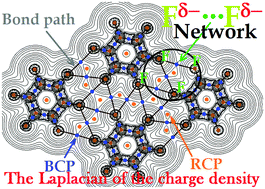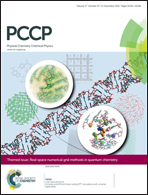Unusual bonding modes of perfluorobenzene in its polymeric (dimeric, trimeric and tetrameric) forms: entirely negative fluorine interacting cooperatively with entirely negative fluorine†
Abstract
The Fδ−⋯Fδ− intermolecular synthon was recently observed to be useful for generating a two-dimensional layered supramolecular architecture on the Ag(111) surface (Kawai, et al., ACS Nano, 2015). This was formed when the entirely negative covalently bonded fluorine atoms in phenyleneethynylene(bis(2,3,5,6-tetrafluoro-4-(2,3,4,5,6-pentafluorophenylethynyl)phenyl)-ethyne (BPEPE-F18)) were in close proximity to the same atoms in another BPEPE-F18 molecule. With a view to provide rigorous insights into the physical chemistry of such an intermolecular synthon, we have selected perfluorobenzene (C6F6) as a model compound, and have performed extensive DFT-M06-2X/6-311++G(d,p) investigations on a number of its homomolecular dimers, trimers, and tetramers. Of the twelve (C6F6)2 dimers investigated, a displaced-parallel arrangement with an uncorrected binding energy (ΔE) of −7.4 kcal mol−1 was found to be the most stable, and an incorporation of the basis set superposition error (BSSE) has significantly reduced its ΔE to −4.7 kcal mol−1. Besides, the ΔE for a minimum-energy least stable conformation of the same dimer, which involves a single σhole(−)⋯σhole(−) type Fδ−⋯Fδ− intermolecular bonding interaction, amounts to −0.62 and −0.24 kcal mol−1 without and with BSSE, respectively. The geometry of another conformation of the dimer, which accompanies a set of three Fδ−⋯Fδ− intermolecular interactions somehow similarly to those observed in the layered supramolecular structure formed by the BPEPE-F18 molecules, lies at a relative energy of 6.5 kcal mol−1 above the most stable conformation. Passing from the latter dimer to an analogous (C6F6)3 trimer, as well as from the trimer to an analogous (C6F6)4 tetramer, the latter two clusters comprising windmill-type Fδ−⋯Fδ− intermolecular topologies, we have marked a preferential increase in the value of ΔE from −0.94 (dimer) to −2.76 (trimer) to −4.49 kcal mol−1 (tetramer), thereby suggesting the presence of cooperative binding. An energy decomposition analysis has revealed that dispersion and polarization are the principal driving forces that bring the C6F6 molecules together in complex configurations. While a reasonable agreement was found between the charge density based topological results of the intermolecular bonding interactions that emerged from the application of Quantum Theory of Atoms in Molecules (QTAIM) and Reduced Density Gradient approaches to all the polymeric compounds, the results of the latter method were found to be too vague especially near the (3, +1) ring critical point regions. QTAIM's source function analysis has suggested that the fully negatively charged fluorine atoms in C6F6 serve as sinks for the Fδ−⋯Fδ− bond formation.


 Please wait while we load your content...
Please wait while we load your content...